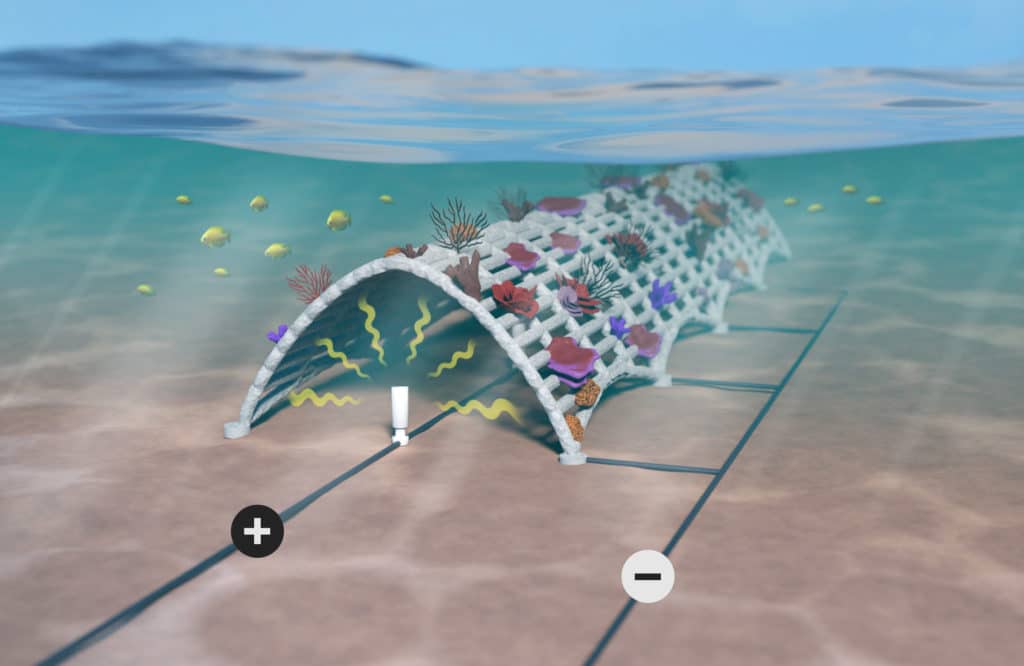United Kingdom (London)
Wave power is being harnessed to grow beautiful artificial coral reefs for coastal protection and marine life.
Coastlines and beaches are dynamic, living landscapes. They evolve and erode as sand gets blown by wind and tumbled by destructive waves; sandbars and pools arise and disappear; and dunes shrink and migrate. Thanks to climate change, storms are becoming more frequent and ferocious, leading to the accelerated erosion of coastlines. This leaves many coastal communities and low lying areas increasingly vulnerable to flooding and damage.

Existing methods for protecting coastlines – seawalls, revetments and dykes – are expensive, use a lot of concrete and rarely look good. By contrast, coral reefs are a natural and sustainable solution. However, rising water temperatures and acidity is leading to bleaching and ultimately death. When corals are stressed, they expel the symbiotic algae living in their tissues, causing them to turn completely white. Sadly, the world has lost over half of all its reefs, which provide a habitat for a quarter of all known marine species.
Now imagine a hi-tech digital solution that rapidly grows beautiful new coral reefs that mimic nature; using seawater minerals and renewable power to protect coasts from erosion. CCell is harnessing the power of waves to produce electricity, which they use to grow beautiful artificial coral reefs. By growing faster than in nature, this is a natural, beautiful, long-term solution that will provide coastal protection, enhance marine ecosystems and promote tourism.
The world’s first eco-based coastal protection powered by renewable wave energy was created by hydrodynamic consultant and civil engineer Will Bateman to harness the power of nature and provide an active breakwater to protect shores from erosion and enhance beaches.
“Any swimmer will have witnessed that beneath ocean waves the particles of water move in orbits: towards the shore beneath a crest then back towards the open ocean in a trough,” Will explains. “Our CCell device harnesses surge motion within the waves using a large curved flap. The motion of this flap is then used to drive a pump, which can either be used to pump a fluid or power an electrical generator.”

The simple and sturdy biomimicry design involves an ultra-light curved paddle that is able to withstand extreme conditions – harnessing energy within ocean waves to generate electricity. After CCell-Wave has captured wave energy, small electrical currents extract minerals (mostly calcium carbonate) within the sea water to form rock around steel wire frames placed on the seabed. This ‘electrolytic’ technique grows artificial reefs that provide a foundation on which to grow corals at an accelerated rate.
The combination of 3D bathymetry maps, global climate models and local wave buoy data is used to develop a numerical model that approximates waves and currents in the area. ‘Bathymetry’ is exactly what it sounds like – the study of underwater depth of lake or ocean floors. The solution is remotely monitored through a 3G mobile link, which allows engineers to fine-tune power to the reef and monitor the health of the paddles.

In 2020, CCell was accepted into Solar Impulse’s World Alliance of Efficient Solutions, joining the ranks of 1,000 global solutions that will change the world with a more sustainable infrastructure, to protect and preserve the planet’s marine ecosystems and to capture renewable energy one wave at a time.

To protect beaches by growing beautiful coral reefs using 100% renewable energy, CCell provides a natural solution that will transform the traditional coastal protection industry. Will’s vision is unique, because it not only tackles a major biodiversity issue, but the issue of coastal resilience too. Plus, it helps maintain beautiful beaches and creates new and exciting dive sites – also helping to promote ecotourism.

AtlasAction: Keep up to date with CCell’s blog full of environmental optimism, accessible up-to-date science and travel titbits.
Project leader
Dr. Will Bateman, Founder and CEO, CCell
Support the Atlas
We want the Atlas of the Future media platform and our event to be available to everybody, everywhere for free – always. Fancy helping us spread stories of hope and optimism to create a better tomorrow? For those able, we'd be grateful for any donation.
- Please support the Atlas here
- Thank you!


